Comparison of the pros and cons of Wall oven and Range Stove
Thinking about upgrading to a snazzy wall oven and cooktop duo instead of sticking with your trusty range? Well, brace yourself for the cost – it might be a tad higher, okay, maybe a lot higher. But hey, there's a silver lining! Opting for separate appliances comes with its perks. Imagine never having to bend down to check on your roast again – now, that's priceless, isn't it?
Life's all about making decisions, and we're here to make it a breeze for you. Let's dive in and break it all down together!
Advantages and Disadvantages of a Wall Oven
Wall ovens are super flexible and convenient—you can customize them to match your cooking style. But hey, there's a catch. It's not just about buying the oven; it's like signing up for a kitchen upgrade package, with cabinet and electrical work, plus labor costs—all adding up.
Advantages:
No more bending over:
When you're carefully taking out that delicate pastry from the oven, worrying about bumping into things becomes a thing of the past if your oven is at eye level.
Cooking with company:
Ever been so focused on cooking on the stovetop that you forget about what's in the oven below? Having separate cooking zones with Wall ovens means you and your cooking partner can each have your own space, making teamwork a breeze.
Flexibility:
Having multiple Wall ovens allows you to cook different dishes simultaneously without taking up extra floor space. It's a smart use of available wall space!
Safety:
Placing Wall ovens at eye level reduces the risk of accidents, especially with curious kids around. It's all about making your home safer.
Downsides:
You'll need to buy a separate cooktop:
Yep, you'll have to invest in a standalone cooktop, as mentioned earlier, pairing it with a wall oven can be pricier than getting a range. Choosing the combo of a wall oven and cooktop means taking on the combined cost.
You'll need to update your cabinets:
Finding space for your Wall oven and Cooktop means inevitable cabinet updates. Once you've cut into those new stone countertops, you're committed to specific sizes and shapes for the cooktop.
You'll need an electrician to update the circuits:
Running both of these appliances requires dedicated lines or circuits for better safety, which means calling in an electrician for installation—a cost you'll need to factor in.
The Upsides and Downsides of a Slide-in Range
So, you're thinking about a slide-in range? You're not alone! It's like the MVP of kitchen appliances because it's easy on your wallet. Plus, you'll save on installation costs. Score!
Pro: Money Saver
Why get two separate gadgets when you can have both stove and oven in one sweet package? It's like hitting a jackpot, unless you're eyeing a fancy showpiece like a La Cornue.
How much dough are we talking about? You could snag a top-notch range for $1,000 to $2,000. But if you're going for separates, be ready to shell out $500 to $1000 for your cooktop and $1,500 and up for a wall oven.
Pro: Space Saver
Talk about efficiency! Combining your oven and stove into one unit means you've just won back some precious kitchen real estate. Hello, bigger island or dining table! And if you've got wall space for an oven, you've got bonus storage for all those blenders, Tupperware oddities, and heirloom china from Grandma.
Con: Oven's Down Low
Sure, bending down to grab your baked goodies might not bother you now. But imagine a few years down the road, when you're not as spry as you used to be. Suddenly, lifting that cake out of the oven feels like a workout, and checking the turkey's temperature? It's like you're in the Olympics! Trust me, that Thanksgiving turkey will feel twice as heavy when you're hoisting it up from a knee-level oven.
Whatever you do, you will probably be more satisfied in the long run if you base your decision primarily on the functional features of the appliance or combination that best meet your personal cooking needs.

 EN
EN
 AR
AR
 BG
BG
 HR
HR
 CS
CS
 DA
DA
 NL
NL
 FI
FI
 FR
FR
 DE
DE
 EL
EL
 IT
IT
 JA
JA
 KO
KO
 NO
NO
 PL
PL
 PT
PT
 RO
RO
 RU
RU
 ES
ES
 SV
SV
 TL
TL
 IW
IW
 ID
ID
 LV
LV
 LT
LT
 SR
SR
 SL
SL
 SQ
SQ
 HU
HU
 MT
MT
 TH
TH
 TR
TR
 FA
FA
 MS
MS
 GA
GA
 IS
IS
 HY
HY
 AZ
AZ
 KA
KA
